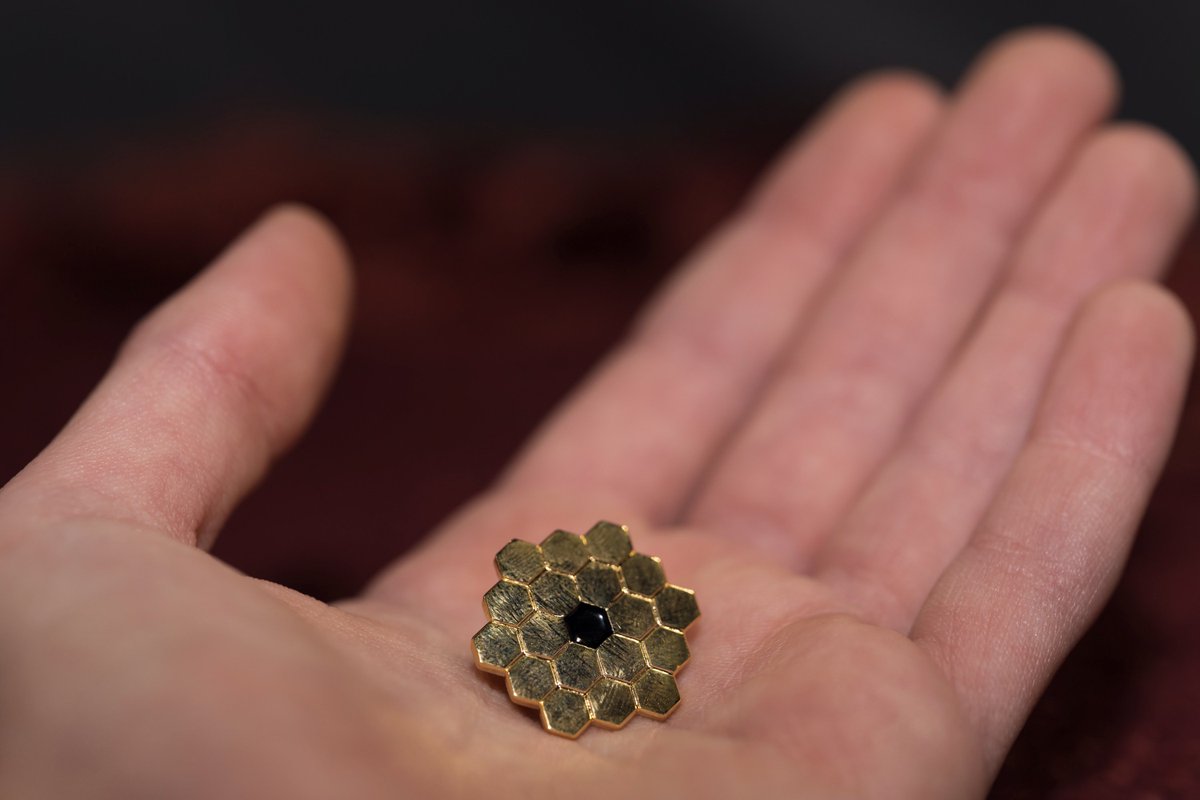
🧵One of my very favorite #JWST science stories concerns the mirror gold. This seem like a good time to tell it. As with all good stories, it has been told before, but I think it is worth a rant. And at the end, there will be a twist. 1/ 

Take another look at that mirror, now collecting light from universe. It is coated in 48 grams of the purest gold, protected by another thin layer of glass. The gold of Webb will help us understand its own cosmic origins. 2/ 

To me, this is a realization of Carl Sagan's words, "we are a way for the cosmos to know itself". #JWST's gold, shaped by humans, will gather light radiated by its own formation, billions of years ago. 3/
The gold is used on the mirrors because it is a near-perfect reflector of infrared light, more than 98% of it, to be precise. You won't see it used for regular telescopes, because it is a poor reflector of blue light - the very reason for the golden color! 4/
How will #JWST help us understand the origins of gold? Well, we thought for decades that the heaviest elements (anything heavier than iron) were created in the fireballs of supernova explosions. 5/
The problem is that the supernova math does not seem to work out.
The heaviest elements in the universe are mostly formed through the so-called r-process (r for "rapid"), in which a shower of neutrons build up large radioactive atomic nuclei that decay to stuff like gold or uranium. 7/
But when you really try to calculate how much of each heavy element a supernova can make, you just can't get enough neutrons to make all the gold and other heavies. Astronomers started to look elsewhere. 8/
Neutron stars... The remnant cores of dead massive stars, so dense that they compress all their electrons and protons into neutrons, yet not massive enough to become black holes. There is no bigger pile of available neutrons than a neutron star. 9/ 

But how do you get the neutrons out and into a place where they can produce loads of gold through the r-process? Why, you smash two neutron stars together, of course! 10/
I'll admit that at this point, the story seems like it's going off the rails, but here we are. 11/
Massive stars often form in pairs, and when they die, they can create a pair of orbiting neutron stars. Over the course of an enormous amount of time, maybe 100 million years, the orbit decays bringing the neutron stars closer and closer together. 12/ 

Why do the orbits decay? Because neutron stars are massive and dense enough that their motion twist space-time itself, emitting gravitational waves, and losing energy. Mind-boggling, when you think about it. 13/
Eventually, the neutron stars collide, emitting a huge burst of gravitational waves. It is quite new tech, but we can now detect these bursts across the universe, using gravitational wave detectors like LIGO. We know this actually happens! 14/
In the collision (or "merger"), the neutron stars are torn apart in a way nothing else could, releasing massive amounts of neutrons, and creating more gold than you can shake a stick at. Maybe 10 earth masses worth per collision. 15/
Or so we think. We're not sure. As you can imagine, these events are rare. So when we see one, it usually happened in galaxy far, far away. The fireball of forming gold is pretty faint, but Andrew Levan and friends (@fox_ori) spotted one in 2017. 16/ 

And so we return to #JWST. In the first year, several observing programs will attempt to catch the fireball from a neutron star merger as it is happening to look for the signatures of the heaviest r-process elements. 17/
When a gravitational wave from the merger is detected, investigators can trigger a target-of-opportunity observation, and within a couple of weeks point #JWST's sensitive cameras at the fireball. 18/
Not every event can be seen - #JWST cannot see the whole sky at any given time because of the sun, but I think we will eventually be able to establish if the gold of the cosmos is made in this crazy way! 19/
Ok, I promised a twist. There is actually way more gold in the Earth than what meets the eye. And we may have had much less, had circumstances been different. 20/
When the Earth had just formed, it was molten. As a consequence, pretty much all the really heavy elements, including gold, sank to the core, out of our reach forever. By some estimates there is enough in the earth's core to cover its surface in a foot of gold. 21/
The reason we have gold to mine today is because we were hit by a shower of gold-rich asteroids after the surface had solidified. Had the architecture of the solar system been a bit different, this bombardment may never have happened, but it did. 22/ 

And so through a twisted journey, from neutron star mergers, wrinkles in space-time, trials and tribulations, loss and gain, we were able to have gold for Webb's mirror. Lucky us! 23/
You can read more in @josh_sokol 's awesome article quantamagazine.org/did-neutron-st… and @NASAWebb 's Elements of Webb series also has an entry on gold. 24/end rant/
• • •
Missing some Tweet in this thread? You can try to
force a refresh





